Google PageRank or PR for short seems to be misunderstood by so many webmasters and SEO specialists that in this part of the SEO Tutorial I will try to explain the ins and outs of the Google PageRank algorithm without getting too deep into the technical maths behind the PageRank algorithm.
Let’s hope so anyway, not easy to explain PR without dealing with some Maths!
Over the years I’ve wrote several SEO articles on PageRank including: Google PageRank and Page Rank which describes the difference between PR and Page Rank (some webmasters get confused) and PageRank Explained which covers a general overview of what PageRank is.
What is Google PageRank?
No better place for a description of PR than Google itself, from Google’s PageRank Explained page-
PageRank relies on the uniquely democratic nature of the web by using its vast link structure as an indicator of an individual page’s value. In essence, Google interprets a link from page A to page B as a vote, by page A, for page B. But, Google looks at more than the sheer volume of votes, or links a page receives; it also analyzes the page that casts the vote. Votes cast by pages that are themselves “important” weigh more heavily and help to make other pages “important.”
Important, high-quality sites receive a higher PageRank, which Google remembers each time it conducts a search. Of course, important pages mean nothing to you if they don’t match your query. So, Google combines PageRank with sophisticated text-matching techniques to find pages that are both important and relevant to your search. Google goes far beyond the number of times a term appears on a page and examines all aspects of the page’s content (and the content of the pages linking to it) to determine if it’s a good match for your query.
Couldn’t have said it better myself, seriously though it’s clear from the above PageRank is very important to Google, it’s the foundation of their original search engines algorithm and so very important to search engine optimization rankings.
PageRank is created or transferred through links and it’s cumulative, a webpage with a high PR transfers more PR than a webpage with low PR making different PR valued links not equal in value from an SEO perspective.
Although 2020 Google SEO has many more ranking factors (Google says over 200) which means the importance of PR must have been devalued over the years: more search engine ranking factors means the older ones like PageRank must have less importance now.
PageRank, which is a measure of a webpages backlinks is still important in 2020+.
Public PageRank Values
Google used to publish the PageRank of webpages publicly, but it stopped providing PR to the public many years ago.
I’m afraid there is no accurate way to determine a specific webpages PageRank, plenty of businesses have tried to provide a PageRank like measure of a webpages value like Page Authority (PA) and Domain authority (DA), but they are not PageRank.
All because Google no longer publishes PageRank values publicly does not mean PageRank is no longer important or no longer part of the search engine algorithms. Simply means we can’t look at a webpage like this one and say it’s PR5 or PR7, we don’t know, it has a PR value of between PR0 and PR10 (most likely between PR3 and PR5) which Google uses in it’s organic search algorithm.
What Does a Specific PR Represent?
Every Google indexed webpage has a hidden PR value between 0 (the lowest) and 10 (the highest), PageRank is based on a log scale, probably around base 6 to 8: we don’t know for sure, but it doesn’t really matter if we get it wrong since it’s all relative.
This means each PR point increase takes 6 to 8 times the effort as the last PR increase, this can be represented as a point system that used to be very helpful when analysing PR transfer for reciprocal link exchanges (no use since public PR was disabled).
PR Points Table if PR is Base 8
PR1 = 8 points
PR2 = 64 points
PR3 = 512 points
PR4 = 4,096 points
PR5 = 32,768 points
PR6 = 262,144 points
PR7 = 2,097,152 points
PR8 = 16,777,216 points
PR9 = 134,217,728 points
PR10 = 1,073,741,824 points
As you can see the difference between PR1 and PR2 is not the same as the difference between PR2 and PR3. Higher a webpages PageRank goes harder it is to go even higher. It might help to imagine each point is the result of a link either directly or indirectly from other webpages.
Note: this isn’t accurate, but it helps to picture the difference between say a PR4 page and a PR7 page, PR4 pages takes 4,096 links, PR7 page 2,097,152 links, that’s 512 times more links or 512 times the effort if all links were equal!
Original PageRank Formula
It’s not important that you fully understand the original PageRank formula to use PR to your advantage, but here it is for those who would like the details.
The original PageRank paper on The Anatomy of a Search Engine authored by the founders of Google Sergey Brin and Lawrence Page we have the the original PageRank formula-
We assume page A has pages T1…Tn which point to it (i.e., are citations). The parameter d is a damping factor which can be set between 0 and 1. We usually set d to 0.85. There are more details about d in the next section. Also C(A) is defined as the number of links going out of page A. The PageRank of a page A is given as follows:
PageRank Algorithm Code
PR(A) = (1-d) + d (PR(T1)/C(T1) + ... + PR(Tn)/C(Tn))Note that the PageRanks form a probability distribution over webpages, so the sum of all web pages’ PageRanks will be one.
PageRank or PR(A) can be calculated using a simple iterative algorithm, and corresponds to the principal eigenvector of the normalized link matrix of the web. Also, a PageRank for 26 million web pages can be computed in a few hours on a medium size workstation. There are many other details which are beyond the scope of this paper.
There’s probably been some changes over the years (most likely to irritate those offering SEO Services :-)), but the guts of the PageRank formula is unlikely to change in the near future, so we can safely use it as a jump off point for SEO analysis.
PageRank Prediction Calculator
The formula above is cumbersome to work with in the real world since it involves countless iterations of the calculation to reach a PR value and since we don’t know all the variables for a specific page we can’t accurately predict PR for any webpage using the original PageRank formula as part of PR calculations!
What we can do though is estimate PR transferred through a link using a simplified PageRank formula, it’s rough and ready, but was useful (when PR was public) when setting up reciprocal link exchanges for those building backlinks, you could predict roughly if a link exchange results in more link benefit to your site or your reciprocal link partners site.
First we simplify the PageRank Formula to only determine PR transferred through a single link by replacing the PR value (PR(A)) with the corresponding value (which we will call PR(pts)) from the PR points table we listed earlier (repeated below). C(A) is from the original formula and represents the number of links from the page in question. For those interested we use 0.85 because it’s generally believed the dampening factor in the original formula (1-d) is 0.85.
PR(pts) * 0.85 / C(A) = PR points transferred through one link
PR Points Table using Base 8
PR1 = 8 points
PR2 = 64 points
PR3 = 512 points
PR4 = 4,096 points
PR5 = 32,768 points
PR6 = 262,144 points
PR7 = 2,097,152 points
PR8 = 16,777,216 points
PR9 = 134,217,728 points
PR10 = 1,073,741,824 points
PageRank Example Reciprocal Link Exchange PR Calculations
We have a PR5 page with 49 links from it, you want to setup a reciprocal link exchange with this webpage which will take the number of links to 50. We look at the PR points table above and see PR5 equates to 32,768 PR points, plugging these values into our simplified PR formula-
32,768 * 0.85 / 50 = 557 PR points
We compare this figure on the table for the closest match. 557 is closest to 512 PR points or a PR3 (PR3 = 512 points). We can predict a single link from the PR5 page above would likely result in a PR3 page if no other links are involved.
We repeat the PR calculation for your links page. You have a PR5 page with 15 links from it, if you setup this link exchange that’s 16 links, what PR would your link partner receive?
32768 * 0.85 / 16 = 1,740 PR points (approx 3 times the PR points you’ll gain)
We compare this figure on the table for the closest match. 1,754 is between 512 PR points (PR3) and 4,096 PR points (PR4). So a single link from your PR5 page above would likely result in a stronger PR3 page (possibly a low value PR4 page) than your link partners if no other links are involved.
Easiest way to use this information is to compare the end results directly-
Partner Links Page: 32,768 * 0.85 / 50 = 557 PR points
Your Links Page: 32,768 * 0.85 / 16 = 1,740 PR points
Your partner gains 1,197 PR points (17,540-557) than you do, this is enough to make two more PR3 pages (2*512=1,024 is very close to the the extra points).
You then have to ask yourself is this reciprocal link exchange in your best interest from a PR point of view. On the face of it no, but you should look at the page/site you are exchanging links with. Is it a popular site, are you likely to receive click thru visitors etc…? Enough PR points to create a couple of PR3 pages isn’t that much of a big deal, the calculation below is where you should think twice about a link exchange.
85% of the PR of a web page is transferred to the web pages it links to, shared equally between all unique links.
Potential link partners PR7 page with 199 links from it (200 after the exchange).
You have a PR6 links page with 9 links from it (10 after the exchange).
Partner PR7 Links Page: 2,097,152 * 0.85 / 200 = 8,913 PR points (two PR4 pages).
Your PR6 Links Page: 262,144 * 0.85 / 10 = 22,282 PR points (five PR4 pages).
Even though the link partner has a PR7 page the large number of links from it makes it worth far less than the PR6 link. I wouldn’t make the above reciprocal link exchange if I owned the PR6 page, but would if I owned the PR7.
Since we no longer have access to public PR the calculations above are academic. That being said what you should take from this is if setting up reciprocal links consider the total number of links (internal + external) links from a partners webpage. If you are offering a link from a webpage with only 10 links and their webpage has 200 links, it’s probably not a fair link exchange.
David Law

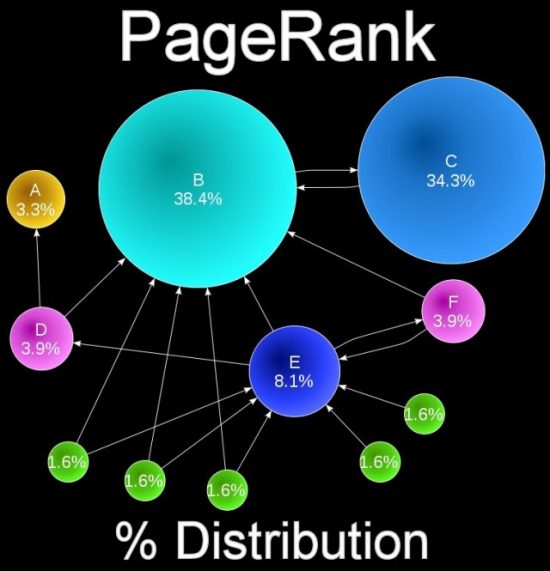
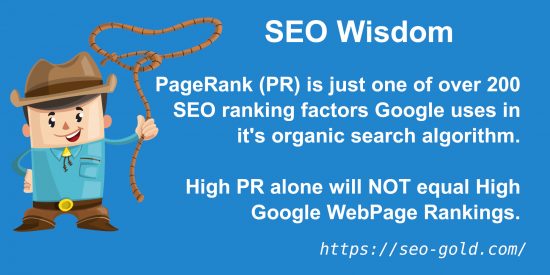
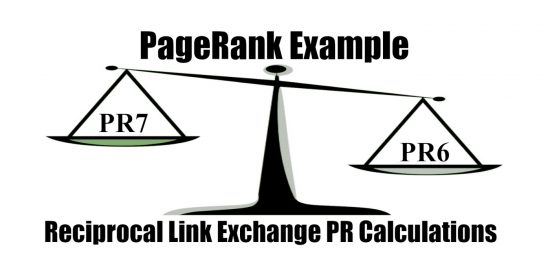





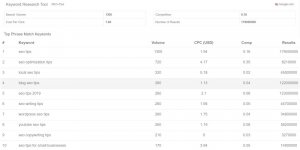

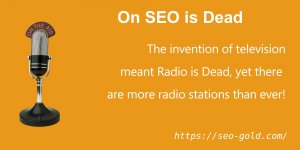




is pagerank effects google ranking?
Yes PR is still important, it’s a measure of the quality/quality of a pages links.
I dont think that PR is so important, i think you need better a good ranking in google.
And what is more important? is it PR or good ranking in google?
What do you recommend to start with, in order to obtain better results?
thanks
it’s the true concept that the page ranking is a important factor to improve ur ranking on the web site .So we wil improve ur web site in yahoo, google and msn but sir i my opinion if we r using the concept of the log formation .We will be find the exact result .
if we r using the probability formate we will find the exact result in little bit of time…………….
how can i increase pr through link building or content editing
Any one tell me that how may I use pr2 to the blog comments….actually i have no idea about it….please explain this…and if possible please send me some pr2 blog list….it will be helpful for me…kindly do that for me….
thank you
With the increasing influence and change of marketing focus to Internet, we have the usual unsavoury characters arriving on the scene. Where there is money, there is a scam. SMEs are particularly vulnerable to this as most do not have the resources, the time or the knowledge to distinguish a genuine SEO company from the fraudsters.
Let us start at the beginning and explain to the uninitiated what SEO (Search Engine Optimisation) is. Search Engines use a technology known as ‘spiders’ to seek out websites, making a record of the website content and then using their unique algorithm to judge whether or not the content of the website is relevant to the search phrase requested by a web user. Each search engine uses a different algorithm, putting different emphasis and weighting on different factors such as content, word density, meta-tags, usability, together with a range of qualitative and quantitative measurement matrices.
Search Engine Optimisation is a method which improves the visibility of a website within the results pages of free search tools such as Google, Yahoo!, MSN, AOL and so on, by strict compliance to the search engine’s algorithm. SEO actions should enhance the relevance of your website for your chosen keywords/keyphrases, improve usability and therefore increase the relevant traffic to your website.
Here are the telltale signs that should send the alarm bells ringing in your head and therefore avoid falling for one of the many scams that is plaguing SEO industry.
Ah yes.
Pagerank. It is very relevant for getting traffic to your site. But keep in mind where the traffic is linked to. If users are linked to your site’s homepage, all the pages in your site profit because they’re linked too. However, your homepage PR may profit even more if the sites below your homepage are linked. As long as you have enough content there. Anyway, it pays if you think it over…
Yes , Page rank, effects google ranking, when we do link building, it is done on bases of pr’s . so as we add inbound links from the well know google ranking websites , the google ranking of the our existing website would also increase. thats how it works.
By the help of other well known websites, our website rank also boost up on the google. also these link transfer is done by mutual agreements.
If the basic concept behind reciprocal link exchange is giving and gaining pr points, does it mean that 2 webmasters who make a link exchange are SMART one and DUMB one? Because only one of them takes more then gives. If, theoretically, given points=taken points so no one benefits at all (the seo situation is the same before and after such exchange).
What is wrong with such reasoning?
PageRank/Link benefit during a reciprocal link exchange does generally result in one winner and one loser, so yes. The trick is to be the winner most of the time, use the PageRank Simplified Formula above for determining if a reciprocal link exchange is a good link exchange.
Also don’t forget it’s not just about PR/link benefit. There’s a lot of SEO benefit in just having a link point to a site because of the anchor text and the fact there’s a link to your site.
So if you know people you trust regarding link exchanges you can setup a groups of link exchanges where overall no one gains/loses much PR/link benefit, but have a few dozen links helps because they are links and they have SEO’d anchor text.
David
I understand the basics, but it’s still pretty daunting isn’t it? I didn’t think that reciprocal links really counted for anything anymore?
FASCINATING!!!
I’m new to the SEO game but it seems to me if we had a good estimate of the “Base” we could perform very accurate analyses.
The formula is simple:
let:
b= the base
N= total number of pages on the internet
Then:
b**10=N
check as estimate with N=1 billion ie. N=10**9
Then b=antilog (9/10) ~= 7.9 which is very close to your estimate of 8.
I know this may be an oversimplification but might be useful if we knew the total number of pages on the internet. So that’s the next question in my mind.
Just a thought,
Bill
I not only agree that PageRank is important in the Google algorithm, I believe that HomePage PageRank is the top factor. The second factor is a boost that Google gives to the effective PageRank of a HomePage when the HomePage is competing for a keyword.
Sir, I have no more idea about pagerank,.. I want to know , if I create a backlink on page like example1.com/page1/(PR0).., But example1.com has PR5, then I’ll get benefit or not..?
I have near about 30 dofollow sites (From PR-1 to PR 9), But I am confused, and not creating backlinks for my site.
If I create a backlink on a page (where individual page’s rank is 0), but website’s page rank is 8, Then….what will happen..? and, i’ll get benefit of PR8 or PR0..?
Please reply as soon as possible.
Thank You Sir
Though I don’t understand how SEO toolbars can tell me that a site has X or Y page rank, I think there are some guidelines that help us figure it out.
The amount of links and the anchor text used, the niche, etc. can all impact the quality of an inbound link. Thanks for sharing.
Thanks so much for taking the trouble to explain the maths behind PR.
while I think (myself included) most webmasters understand the principles, it can get very difficult to calculate the resultant set of link benefit from one backlink.
It’s also important to note that reciprocal links gain more points when within similar niches or industries than two reciprocal links that are completely unrelated.
Hi SEO Dave
I’m impressed by your math skills.
Do you have a formula for working out how many PR1 backlinks equals a single PR9 link?
Cheers
Peter